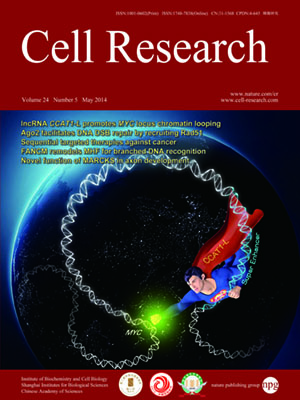
Volume 24, No 5, May 2014
ISSN: 1001-0602
EISSN: 1748-7838 2018
impact factor 17.848*
(Clarivate Analytics, 2019)
Volume 24 Issue 5, May 2014: 542-559
ORIGINAL ARTICLES
Biomarker-guided sequential targeted therapies to overcome therapy resistance in rapidly evolving highly aggressive mammary tumors
Ozgur Sahin1,2, Qingfei Wang1, Samuel W Brady1,3, Kenneth Ellis1, Hai Wang1, Chia-Chi Chang1,3, Qingling Zhang1, Preety Priya1,3, Rui Zhu4, Stephen T Wong4, Melissa D Landis4, William J Muller5, Francisco J Esteva6, Jenny Chang4 and Dihua Yu1,3
1Department of Molecular and Cellular Oncology, The University of Texas MD Anderson Cancer Center, 1515 Holcombe Boulevard, Houston, TX 77030, USA
2Department of Molecular Biology and Genetics, Faculty of Science, Bilkent University, Ankara, Turkey 06800
3Cancer Biology Program, Graduate School of Biomedical Sciences-Houston, TX 77030, USA
4The Methodist Cancer Center, Houston, TX 77030, USA
5Goodman Cancer Center, McGill University, Montreal, Quebec, H3A 1A3, Canada
6Department of Breast Medical Oncology, The University of Texas MD Anderson Cancer Center, Houston, TX 77030, USA
Correspondence: Dihua Yu, Tel: 713-792-3636; Fax: 713-792-4544(dyu@mdanderson.org)
Combinatorial targeted therapies are more effective in treating cancer by blocking by-pass mechanisms or inducing synthetic lethality. However, their clinical application is hampered by resistance and toxicity. To meet this important challenge, we developed and tested a novel concept of biomarker-guided sequential applications of various targeted therapies using ErbB2-overexpressing/PTEN-low, highly aggressive breast cancer as our model. Strikingly, sustained activation of ErbB2 and downstream pathways drives trastuzumab resistance in both PTEN-low/trastuzumab-resistant breast cancers from patients and mammary tumors with intratumoral heterogeneity from genetically-engineered mice. Although lapatinib initially inhibited trastuzumab-resistant mouse tumors, tumors by-passed the inhibition by activating the PI3K/mTOR signaling network as shown by the quantitative protein arrays. Interestingly, activation of the mTOR pathway was also observed in neoadjuvant lapatinib-treated patients manifesting lapatinib resistance. Trastuzumab + lapatinib resistance was effectively overcome by sequential application of a PI3K/mTOR dual kinase inhibitor (BEZ235) with no significant toxicity. However, our p-RTK array analysis demonstrated that BEZ235 treatment led to increased ErbB2 expression and phosphorylation in genetically-engineered mouse tumors and in 3-D, but not 2-D, culture, leading to BEZ235 resistance. Mechanistically, we identified ErbB2 protein stabilization and activation as a novel mechanism of BEZ235 resistance, which was reversed by subsequent treatment with lapatinib + BEZ235 combination. Remarkably, this sequential application of targeted therapies guided by biomarker changes in the tumors rapidly evolving resistance doubled the life-span of mice bearing exceedingly aggressive tumors. This fundamentally novel approach of using targeted therapies in a sequential order can effectively target and reprogram the signaling networks in cancers evolving resistance during treatment.
10.1038/cr.2014.37
FULL TEXT | PDF
Browse 1903


